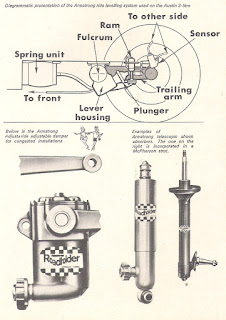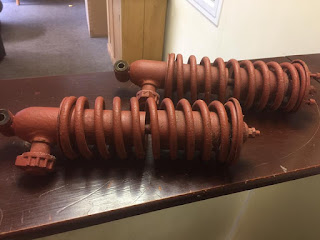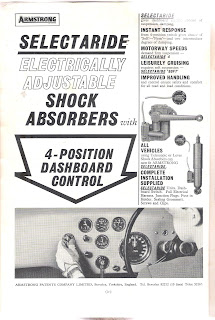The Armstrong Lever Action Shock Absorber
The Armstrong New Super Double-Acting Self-Regulating Hydraulic Shock Absorber is of the Vertical Cylinder Type. All working parts are submerged in oil.Construction
The body A is a zinc alloy die casting and bolts directly on to the frame of the car, the two cylinders B and C being connected by passages E and F. The double crank G and arm H are a force fit on serrated portions of spindle I, which rotates in the body A on generous double bearings. Connecting rods J connect the crank G to pistons K to which non-return recuperating valves N are fitted. The arm H is connected to the axle of the car link L.How it Works
As the axle moves to and from the car frame, so the pistons move in and out of their respective cylinders pumping oil from one to the other. The interior of the body is filled with oil to within 3/8" from top of cover, any shortage of oil beneath the pistons is instantly made good though the recuperating valves N.Cam valve (Self Regulating)
As the car axle moves to and from the car frame the oil pumped from the compression cylinder B to rebound cylinder C or cylinders C to B, and has to pass between the taper ended valve P and scew Q, which is adjustable to offer any desired resistance to the action of the axle.As will be seen from the drawing the upper end of the valve F is held in contact with the cam on spindle I, which means that on fairly good roads the valve P is in its lightest setting and shock absorber gives a normal resistance--just enough--yet not too much to produce harshness, but when bad roads are encountered the spindle I oscillates and the contour of the cam depresses the tapered end of valve P further into the central port of screw Q and thereby increases the resistance of the shock absorber.
The automatic, variable resistance obtained from the cam movement makes this shock absorber entirely self-regulating, the resistance automatically increasing as required thus enabling the car to pass over bad with comfort equal to good roads.
Screw Taper Valve
As the axle moves towards the frame the oil is pumped from the cylinder B to cylinder C, but as it has to pass the spring loaded valve R a resistance governed by the tension on the spring is offered to the movement of the axle.On the return or rebound stroke the oil is pumped from cylinder C to cylinder B, and as the ball valve only opens in one direction the oil must now find its way to cylinder B past the taper screw S, which is adjustable to offer any desired resistance to the rebound of the car spring.
Adjustment of the Cam Valve
Both rebound and compression are controlled by screw Q, to tighten rebound and compression slack nut T, taking care that the screw Q does not turn. Turn screw Q half a turn inwards and lock up the nut, taking care the the screw Q does not turn.To reduce the resistance follow the above instructions, but turn screw outwards.
Screw Taper Valve Adjustment
Both rebound and compression are controlled by screw S.The same instructions apply as for cam valve, but refer to screw S and nut U.
Note.--Shock absorbers adjusted too lightly make your car feel harsh and hard; we recommend slacking off first in case of doubt.
These shock absorbers will only work satisfactorily on Armstrong Super Shock Absorber Oil. Examine your shock absorber oil lever regularly. The correct level is 3/8" from top of cover.
Double Note: I personally have found these shocks to be quite reliable and I have been able to resurect several of these by just general cleaning and fresh oil. You should try that first prior to sending it out for rebuilding.
------------------------------------------------
Adjustable dampers
I had heard these existed and have now found a picture. These can be adjusted on the car without taking them apart.| MG works adjustable Armstrong lever dampers |
Due to the rarity of original adjustable lever arm dampers there are now firms remanufacturing and converting original dampers to be adjustable. One instance is for the MG Sprite with items made in the USA by Peter Caldwell, in Madison, Wisconsin being sold in the UK through http://www.petermayengineering.co.uk/.
 |
| Adjustable Dampers Autocar17 October 1968 |
Non adjustable dampers
Adjusting the units: There is a large hex head 'nut' at the bottom of the units, this can be unscrewed to remove the damper assembly, take care of the 'O' ring. As below:
The damper assembly looks as below when assembled:
The damper assembly looks as below when assembled:
| Armstrong lever arm damper assembly |
Do both together, clamp them together in a vice, then by hand pressure on the end of the levers you can compare their resistances to get them both similar.
Refit to car and test. Hours of fun there then!
Rebound valve adjustment starting point ~ compress back of the car and release, eg kneel on bumper and get off the suspension should return the car to static ride height and no more. It should not bounce beyond static ride height.
Bump damping adjustment ~ although it is ideal to set this low to get minimum vertical upward acceleration that you feel through your seat/spine. Ideally set bump damping as low as you can to prevent bouncing after a series of bumps or wallowing after quick steering inputs.
Borrowed from a Morgan website.
----------------------------------------------
Borrowed from a Morgan website.
----------------------------------------------
Lever Arm Oil
Armstrong sold their own special grade of oil specially for lever arm dampers. What should be used now?Motor bike shock absorber oil seems to be the recommended substitute. It is available in several different viscosities. 20 as used in older bikes is what can be used. Modern lighter grades will not be stiff enough. Stiffer oil such as 30 may damage the seals.
Some people have successfully used trolley jack oil. However it has been said such oil may suffer from foaming when dampers work hard and quickly - just when you want the damping action.
--------------------------------------------------------------------
Simplied later design
| Original Armstrong lever arm damper assembly with o-ring |
 |
| Later simplified Armstrong lever arm damper assembly without o-ring |
According to Alex Pringle on the TR Forum: The old Armstrong Company merged with James Lyon in the early 1970s, and considerable change resulted.
Lever arm shock absorbers, as we think of them, had numerous and varied commercial and industrial applications . . . . automatic door closers being the most often noticed. The old Armstrong company thought of all of these items as appropriate for reconditioning, whereas the new company preferred to simplify (and cheapen) designs - and to abandon reconditioning in favour of straight replacement.
Lever arm shocks manufactured post 1974 or thereabouts were of the simplified variety, until the eventual cessation of mainstream production, towards the end of the decade.
------------------------------------------------------
You tube video
Roadholder
This brochure produced by Armstrong explains the range of Armstrong parts available to tune car suspension. I found this document on the http://mk1-performance-conversions.co.uk/ website a great source for early Mini enthusiast. It shows the optional adjustable dampers available for Triumph cars at the time.
 |
| Armstrong adjustable dampers |
Armstrong adjustable dampers and springs for a works Triumph Spitfire being fettled by Jigsaw classic Triumph specialists. These dampers from the 1960's were supplied from the collection of David Pearson of Canley Classics.
Selectaride
Selectaride electrically adjustable shock absorbers with 4-position "cockpit control". I think this alternative form of adjustability is interesting.Armstrong marketed electrically adjustable shock absorbers with a 4 position "cockpit control" a switch. These dampers were an ultimately unsuccessful product and were dropped by car manufacturers after they proved to be unsatisfactory in service.






